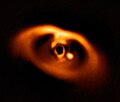References
- 1 2 The Exoplanet Orbit Database, Jason T Wright, Onsi Fakhouri, Geoffrey W. Marcy, Eunkyu Han, Ying Feng, John Asher Johnson, Andrew W. Howard, Jeff A. Valenti, Jay Anderson, Nikolai Piskunov
- ↑ Catalog of Nearby Exoplanets, R. P. Butler, J. T. Wright, G. W. Marcy, D. A Fischer, S. S. Vogt, C. G. Tinney, H. R. A. Jones, B. D. Carter, J. A. Johnson, C. McCarthy, A. J. Penny, The Astrophysical Journal, Volume 646, Number 1, 2006
- ↑ Feng, Ying; Han, E.; Fakhouri, O.; Ford, E.B. (January 2013). "New Features of the Exoplanet Orbit Database at Exoplanets.org". American Astronomical Society . Bibcode:2013AAS...22134003F – via ResearchGate.
- ↑ "Exoplanet Orbit Database | Exoplanet Data Explorer". Archived from the original on 13 May 2023. Retrieved 17 May 2023.
